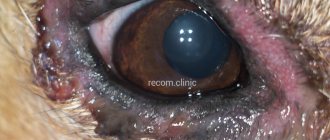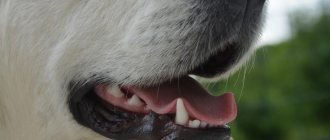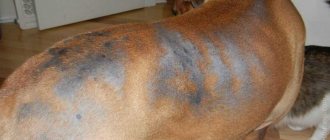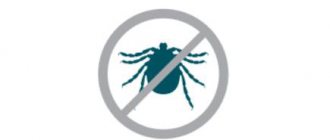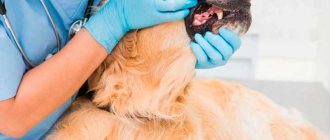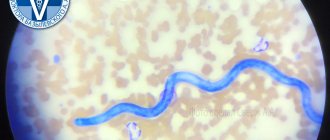Giardiasis in dogs is a disease that is caused by the simplest parasitic pathology Giardia. Unlike humans, dogs with giardiasis are more susceptible to acute and chronic forms of the disease. Various internal organs of the animal may be affected.
Just like in the human body, the small intestine is primarily affected. Damage to this part of the gastrointestinal tract leads to the development of symptoms of dermatological disorders, allergies and neurological irritations.
Giardiasis in dogs
Every dog can become infected with giardiasis. The whole danger lies in the fact that this disease is transmitted not only from animal to animal, but also from a person to his pet. Therefore, problems arise not only in identifying, but also in treating the disease.
The Giardia parasite can be located in the body either as a trophozoid or as a frozen cyst. In the latter condition, the parasitic organism can remain motionless for a long time until it enters the weakened intestine. The first condition in order to reproduce is that the pathogen must have a moist and cool environment.
Giardia parasites spread through secretions containing cysts that enter the environment. The microorganisms then spread through the water and air, moving onto objects that end up in contaminated feces.
Giardia cysts penetrate the digestive tract and dissolve their membrane. This process is helped by gastric juice. After the shell dissolves, two trophozoids emerge from the cyst, which after some time transform into full-fledged parasitic individuals.
Unfortunately, the effect of Giardia on the small intestine has not been reliably studied. But veterinarians adhere to the theory that giardiasis chooses the cavity of the small intestine for its habitat - just like in the human body. Giardia produces toxins and has a destructive effect on the intestinal walls.
These processes interfere with normal digestion and absorption of food. As a result, diarrhea occurs.
To counteract the disease, it is necessary to have strong immunity for both animals and humans.
Source: https://ilive.com.ua/family/lyamblioz-u-sobak_113125i16040.html
What to do at home
The most important thing that the owner of a sick dog must understand is to under no circumstances self-medicate and strictly follow the veterinarian’s instructions. Traditional methods of fighting parasites are ineffective.
It is very important to prevent re-infection, so timely disinfection is of great importance. The room where the pet is kept must be periodically treated with a bleach solution. Care items, bowls, toys are washed with hot water and dried thoroughly.
It is better to remove carpets during the treatment period, but before that they are treated with a steam cleaner and dried. The ideal option is dry cleaning. The dog bed is soaked in hot water, washed and dried.
Giardiasis is contagious, so until complete recovery the patient should not have contact with other animals living in the house. After visiting the toilet, you need to bathe your dog using detergent.
The disease also poses a danger to people, which is why hand washing after each care of your four-legged pet becomes a mandatory procedure.
Giardiasis in dogs, clinical symptoms, diagnosis and treatment
Giardiasis is an intestinal infection in humans and animals caused by the protozoan parasite Giardia.
Giardia is a protozoan single-celled parasite; it is not a helminth, a bacterium, or a virus. The parasite is found throughout the world and is a common cause of traveler's diarrhea.
Some enthusiasts who accidentally drink contaminated water may develop "beaver fever," which is another name for giardiasis in humans.
Other protozoan parasites that can cause intestinal problems include coccidia, toxoplasma and cryptosporidium.
Giardiasis may be a major cause of diarrhea. However, most dogs infected with Giardia do not have diarrhea, vomiting or any other symptoms.
Giardia has two forms:
- a fragile, mobile form that exists in the intestines,
- a nonmotile form (cyst form) that exists in stool and can survive in the environment, including water, for up to several months.
What are the clinical symptoms of giardiasis?
These microscopic parasites attach themselves to the intestinal wall and cause acute, foul-smelling diarrhea.
The stool can range from soft to watery, often has a greenish tint, and sometimes contains blood. Infected dogs typically have excess mucus in their stool. In some cases, vomiting may occur.
These symptoms may persist for several weeks and gradual weight loss may become apparent.
Diarrhea with giardiasis may be intermittent. Most dogs do not have a fever, but may be less active. The disease is usually not life-threatening unless the dog's immune system is weakened.
How do dogs become infected with giardiasis?
Dogs become infected with Giardia when they ingest the parasite in the form of a cyst. In susceptible dogs, once the cyst enters the intestine, it changes into the trophozoite form (the motile form), attaches to the intestinal wall and begins to feed.
If there is a sufficient amount of Giardia, the dog will develop clinical symptoms and develop damage to the intestinal walls. Trophozoites reproduce by fission and some develop into cyst form.
Thus, the dog leaves Giardia cysts in its stool.
These cysts can immediately infect other animals. Giardiasis can be transmitted through food, sniffing contaminated soil, and also by using contaminated water.
If cysts are found in the stool of a healthy adult dog without diarrhea, it is generally considered a temporary, minor occurrence. However, in puppies and weakened dogs, giardiasis can cause severe watery diarrhea, which can be fatal if left untreated.
The likelihood of infection increases if there is a lot of fecal contamination in the dog's environment. Giardiasis often occurs in densely populated areas and environments such as shelters, nurseries and pet stores.
How is giardiasis diagnosed?
Tiny cysts are found when your dog's stool is checked regularly. If your veterinarian suspects your dog has giardiasis, he or she may test the stool for specific giardia antigens. A preliminary diagnosis is often made based on medical history and clinical symptoms suggestive of giardiasis.
How to treat giardiasis?
The most common drug used to treat giardia is the antibiotic metronidazole. It is usually used within 5-7 days. Another antiparasitic drug, fenbendazole, is often used as an adjunct, especially when used with metronidazole.
A combination of these drugs is also often used in cats with persistent and unresponsive diarrhea. In case of dehydration or in case of severe diarrhea, maintenance therapy with other drugs is carried out.
Some dogs require follow-up testing and therapy based on their condition.
What is the prognosis for treatment of giardiasis?
In most cases, the prognosis is positive. Only emaciated or old animals with a severely weakened immune system are at increased risk of complications.
Can a dog infect a person?
Giardia can cause diarrhea in humans and can potentially be transmitted from dogs to people. It is also believed that wild cats and dogs are the main sources of Giardia infection in humans.
However, person-to-person transmission is also very common, and contaminated water supplies are responsible for many outbreaks.
If your dog is diagnosed with giardiasis, you should thoroughly disinfect his environment and maintain strict personal hygiene. In particular, people with immunodeficiency, cancer, or undergoing chemotherapy should handle stool with extreme caution.
For disinfection, you can use chlorine bleach diluted 1 to 32 or 1 to 16. However, make sure that surfaces can be safely disinfected with bleach. Giardia can also be removed with quaternary ammonium compounds (parvosol, etc.).
Giardia cysts are afraid of dry environments, so try to keep the environment as dry as possible.
To achieve the best results, it is necessary to clean all areas accessible to the pet, then dry them for several days, and only then allow the pet to be in its usual environment.
Source: https://PetsTime.ru/article/lyamblioz-u-sobak-klinicheskie-simptomy-diagnostika-i-lechenie
How to treat this disease
| First day | The pet should be put on a diet, or better yet, put on a temporary hunger strike. Since appetite is at an extremely low level, this is very easy. To increase the effectiveness of drugs that suppress Giardia, it is necessary to cleanse the intestines and stomach. For this, astringents are used, enterosorbents such as Enterosgel, low-fat meat broth is useful for support, enemas and other laxatives can be used. |
| Second day | Should start with liquid porridges made from semolina, oatmeal or rice. They envelop the intestinal walls and also promote the adsorption of accumulated toxins. You can add a little ground beef to the porridge for taste. |
| The third day | Try to introduce a little fermented milk products into your diet. Lactic acid actively suppresses all groups of Giardia, and also reduces their resistance to drugs. |
Most often prescribed in the fight against these microorganisms
- Albendazole
- Fenbendazole
- Metronidazole
- Febtal
The latter option is quite good for suppressing Giardia. Course duration is 3 days.
Complex preparations containing anthelmintic components, such as praziquantel or pyrantel, are also often used in the treatment of dogs. The calculation is for every 10 kg of animal weight, and for small dogs the tablets will have to be divided. It is also advisable not to buy medications made for people. The course lasts 3 days, and after a week it must be repeated to destroy Giardia hatching from the cysts.
In chronic cases, up to 10 repetitions are possible under the supervision of a physician. In the most severe conditions, infusion therapy is performed, glucose and vitamins are administered intravenously to prevent them from being eaten by Giardia. It is also possible to use calcium supplements in old age. If persistent diarrhea causes dehydration, distilled water may be added. General supportive therapy is performed in parallel with drug treatment. This complex approach is most often used for dogs in an extremely malnourished state.
In addition to medications, a diet of special dry food may be prescribed. During the treatment period, Giardia must be completely deprived of basic nutritional resources. The process of taking medication is cyclical in order to kill the parasites that gradually emerge from the cysts.
When caring for a pet, it is necessary to completely change the sleeping place, and all family members should always wash their hands, preferably every hour. Where the animal could lie, sit or stand, you need to go through everything with a steam iron. You can use the services of a cleaning company. This is the so-called sterile cleaning. During the treatment period, it is better to remove the animal from the house, live in the country or somewhere outside the city, to eliminate the risk of re-infection. People should also be tested for giardiasis.
Symptoms and treatment of giardiasis in dogs
Parasitic microorganisms Giardia, entering the dog's body, can cause the disease giardiasis. They live in the intestines and can be transmitted to all family members. Giardiasis is less common in domestic dogs than in stray or street animals.
Features of the development of the disease
Giardia is localized in the small intestine and duodenum. They can be active (trophozoites) or immobile in a protected shell (cysts). Trophozoites are able to move around the body, feed and reproduce. They feed on the remains of undigested food and do not need oxygen.
Cysts enter the environment along with the feces of an infected animal. They are shaped like an oblong pear and have four pairs of flagella. They are attached to the intestinal walls with the help of villi and suction cups, which are located in the front part of the body.
Parasites can enter the body in several ways:
- together with water from puddles, rivers or other bodies of water;
- while swimming in open water;
- when interacting with soil;
- through food;
- through everyday objects;
- through toys intended for animals;
- from other infected animals or insects.
Prevention
To protect your animal from repeated or primary infection with giardiasis, you must follow the following recommendations:
- include meat and fish in your menu daily;
- reduce the amount of carbohydrates in your diet (bread, cereals);
- Give multivitamins periodically (at least two courses per year);
- monitor your pet's hygiene;
- do not let your dog have contact with street and unfamiliar animals;
- Do not allow drinking from puddles and ponds.
Many pathogenic bacteria and parasites live in lawns and other bodies of water
Giardia in dogs: symptoms and treatment of giardiasis
Many people's favorite pets, dogs and cats, can be exposed to a considerable number of quite dangerous diseases.
Even as a pet who only occasionally goes outside for short walks, you can quickly find a source of germs and become infected.
One of the most common diseases observed in dogs is giardiasis. This disease occurs due to the entry into the body of a special type of parasitic microorganisms called Giardia. They quickly colonize the intestines and begin to affect the functioning of the entire body.
This disease can be transmitted in a variety of ways: from one animal to another, from humans, from dirty food materials.
Where do parasites live?
In addition to the small intestine, which experiences problems first of all, other internal organs and systems may also be negatively affected. This manifests itself in a variety of ways: disorders of the digestive function, skin rashes, allergic reactions.
Depending on the form in which pathogenic organisms enter the intestines, they can either immediately lead to infection, or they simply remain there for a long time without visible signs, waiting for optimal conditions for development.
Like most harmful microbes, Giardia loves moisture and low temperatures..
The mechanism of the destructive effect of parasites on the animal’s body has not yet been studied precisely enough, but in general it is quite clear - located in the small intestine, they secrete harmful substances called toxins, which help the pests to gain a foothold on the intestinal walls and use it as a source of nutrition.
Being exposed to this effect, the organ gradually begins to work less and less stably, which is accompanied by diarrhea, pain, and poor food processing.
Causes of pet infection
There are several ways in which a dog becomes infected with giardiasis. The most common of them is swallowing food that contains dangerous bacteria.
Unlike many parasites that plague both animals and humans, Giardia can live freely outside the body, in normal street conditions, for a very long time.
Even 2-3 weeks for this will be quite realistic. Therefore, a curious animal that sniffs and tastes everything can easily become infected from many objects.
Possible routes of infection:
- Sniffing objects that have pests. Dogs, as you know, are apt to carefully examine the feces of their fellow dogs passing along the street before them. If the person who left such a mark on the street had bacteria in the intestines, then they will be present in the stool;
- Often the disease enters the animal's body by drinking dirty water, for example, from a puddle. There are also a large number of all kinds of microorganisms that love a humid environment;
- Giardia in dogs, the symptoms and treatment of which will be discussed below, can even be transmitted through the animal’s favorite toys.
Methods of infection
Dogs become infected with giardiasis orally. That is, when Giardia cysts enter the mouth. Most often this happens when drinking poor quality water.
Since Giardia (in the form of a cyst) is resistant to many disinfectants, and sometimes even chlorinated water (if the concentration is insufficient) does not kill them, you can become infected even by simply drinking tap water at home.
Another common method of infection is when a dog, while walking, sniffs the soil contaminated with cysts.
Also, some dogs have the unpleasant habit of eating the feces of other animals. And if another animal was infected with giardiasis, then there are cysts in the feces. This method of infection is called fecal-oral.
Symptoms and treatment of giardiasis in dogs
Giardiasis in dogs is a disease that is determined by the parasitic pathology of Giardia. The effect of giardiasis on the animal body is more acute and destructive than on human organs. Dogs and cats are more sensitive and susceptible to Giardia disease.
The parasites strike first on the dog's small intestine. Dysfunction of this organ results in problems in the area of neuralgia and allergic reactions.
There are no vaccines against giardiasis, and all animals that come into contact with the external environment, other relatives and people are susceptible to infection. The ideal breeding ground for Giardia is moisture and coolness . They become infected through secretions containing cysts.
In order for the dog’s body to resist the effects of Giardia, it is necessary to support it with a strong immune system.
Giardia in dogs can be caused by ponds, puddles, and even toys. Giardia is transmitted by airborne droplets from one animal to another. Therefore, owners of infected dogs should protect their animal from contact with others for the safety of the latter.
Giardiasis is dangerous due to its toxicity, which over time, if no action is taken, accumulates and poisons the entire body. The disease causes destruction of the intestinal walls and dysfunction of new cells. In turn, this circumstance leads the dog’s body to malfunctions in the digestive system.
Important elements and substances designed to maintain the vitality of the animal cease to be absorbed, and the body’s activity malfunctions. Giardia in dogs can lead to the development of lactase deficiency. Another consequence of giardiasis is the development of allergies, initiated by the penetration of antibodies into the depleted intestines.
The last stages of giardiasis threaten serious dysfunction of the digestive system.
Symptoms of the disease in dogs
Symptoms of Giardia in dogs are expressed in a latent form. Giardiasis often does not appear until the disease reaches its most severe stage. At the last stage, giardiasis in cats or dogs is characterized by complete destruction of intestinal cells. In general, manifestations of Giardia in dogs and cats can be reduced to superficial disorders in the intestinal area and mild malaise of the animal.
What is the danger and how to get rid of lamblia in a dog?
Giardia are parasitic microorganisms that live in the intestines of vertebrates. Giardiasis in dogs is quite widespread. If a dog is kept at home, then the probability of infection is 1 case per 100 individuals. Street and stray dogs are almost all sick. The danger of giardiasis is that it can be transmitted to humans.
Causes and development of the disease
Giardiasis is caused by a protozoan single-celled organism that lives in the small intestine. Giardia can be active (trophozoites) or quiescent inside a dense shell (cysts). The cyst helps the microorganism remain viable outside the host's body. When swallowed, the protective shell dissolves, and lamblia begins to actively live and reproduce.
Infection occurs from a sick animal that excretes cysts in its feces. Natural food and water sources become infected. Caution should be exercised when walking and bathing your dog in bodies of water. The sick animal, in turn, becomes a source of infection 1-2 weeks after ingesting the cyst.
Giardia in the intestine is repeatedly sucked in and torn off, damaging the epithelial cells of the villi. And their waste products can have a toxic effect. As a result, disturbances occur in the dog’s body:
- epithelial regeneration in the intestine worsens. Cells destroyed by Giardia are replaced by young, functionally immature ones. There is a failure in the synthesis of important enzymes, lactase deficiency develops;
- large-molecular antigens begin to penetrate through the thinned intestinal wall, causing food allergies;
- Parietal digestion worsens, and a deficiency of important vitamins and microelements occurs.
In advanced, severe cases, the intestines lose up to 50% of their digestive function.
But giardiasis in dogs does not always cause health problems. In some cases, protozoa parasitize the intestines without causing pathological processes or manifesting themselves in any way.
Symptoms of giardiasis
The incubation period of the disease is up to 12 weeks. Giardiasis has no characteristic clinical manifestations. Sometimes it causes other serious diseases or becomes concomitant with chronic digestive dysfunction. But more often the animal simply becomes a carrier of microorganisms.
The acute form of giardiasis is characterized by severe pain in the abdominal area. The dog is worried, whines, and cannot find a place for itself. The stool becomes watery, but there is no blood or mucus in it.
Possible loss of appetite, nausea, increased gas formation (mainly in weakened animals). Body temperature remains normal.
Acute giardiasis is benign and subsides within a week.
Most owners consider these symptoms to be a consequence of poisoning and treat their pets with enterosorbents. This is also true, drugs alleviate symptoms and help quickly relieve an acute condition.
Consequences of giardiasis
In older dogs and animals with weakened immune systems, giardiasis occurs in a more severe form. The disease manifests itself with several signs:
- loss of appetite and weight loss;
- poor skin condition (oily seborrhea);
- increased hair loss not associated with shedding. The hair becomes dull and weakened;
- deep folds and cracks on the lips;
- belching with the smell of hydrogen sulfide;
- signs of general intoxication: lethargy, fatigue, poor health;
- intestinal colic, flatulence, stool disorders (diarrhea followed by constipation);
- bad breath, coated tongue;
- avitaminosis;
- persistent dermatitis;
- chronic otitis;
- disorders of the liver, pancreas
- rarely rickets and dystrophy, etc.
If left untreated, allergic reactions often develop against the background of giardiasis: otitis media, weeping eczema, conjunctivitis, blepharitis. The presence of Giardia in the intestines is suspected if long-term treatment with antihistamines does not produce results. To eliminate unpleasant symptoms, you must first eliminate giardiasis.

